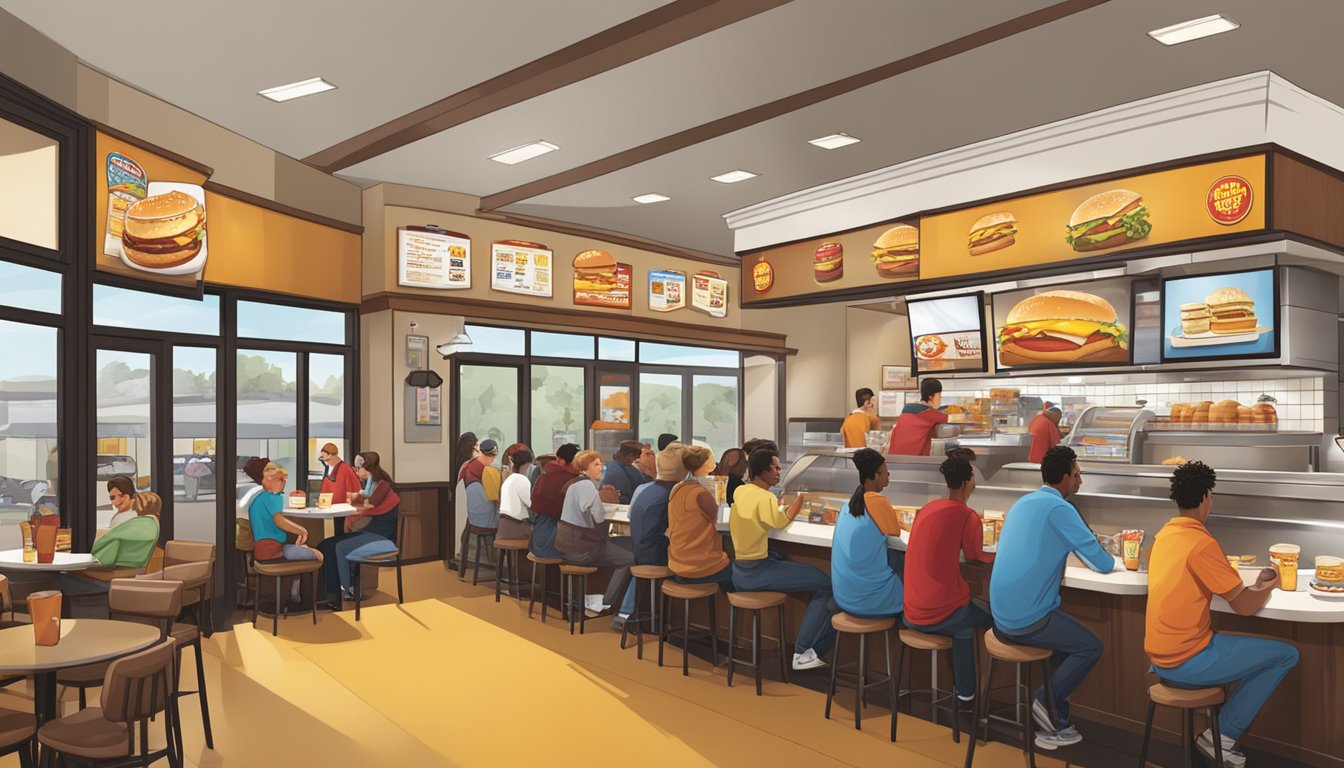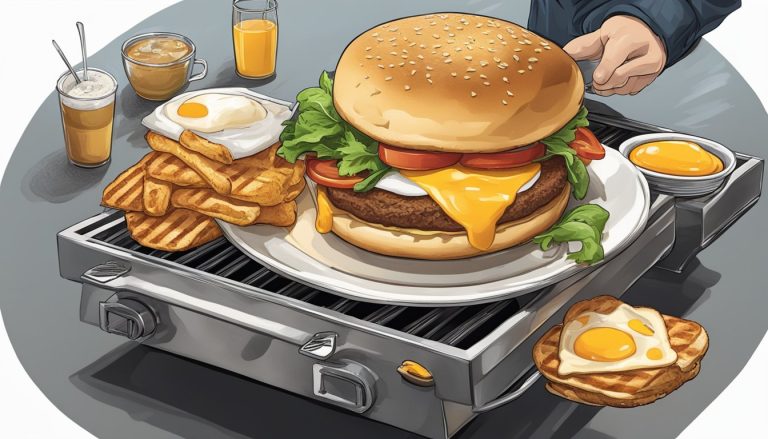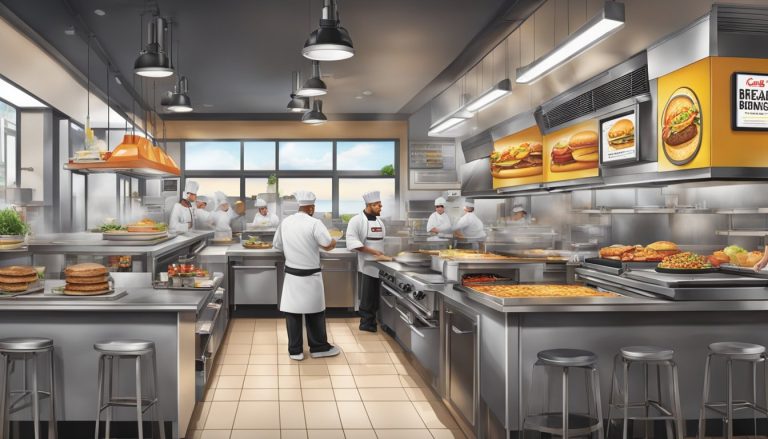Carl’s Jr. has been a fixture in the fast food landscape for over 75 years, serving up classic American fare to hungry customers. The brand’s expansion into breakfast offerings has proven to be a game-changer for many franchisees. Successful Carl’s Jr. breakfast locations have seen significant growth and profits by tapping into the lucrative morning meal market.
These franchise success stories highlight the potential of the breakfast segment in the fast food industry. Carl’s Jr. has adapted to changing consumer preferences, offering a mix of traditional breakfast items and innovative options that appeal to diverse tastes. The brand’s commitment to quality ingredients and customer satisfaction has helped drive loyalty and repeat business during the crucial morning hours.
From small towns to bustling cities, Carl’s Jr. franchisees have found ways to make their breakfast offerings stand out in competitive markets. Their achievements demonstrate the power of a well-executed breakfast strategy in the restaurant industry. These success stories serve as inspiration for current and potential franchisees looking to maximize their investment in the Carl’s Jr. brand.
History of Carl’s Jr.
Carl’s Jr. began as a small hot dog cart in 1941 and grew into a major fast-food chain known for its burgers. The company’s journey spans decades of expansion and innovation in the restaurant industry.
From Humble Beginnings
Carl Karcher and his wife Margaret started their food business with a hot dog cart in Los Angeles. They invested $326, using $15 in cash and borrowing $311 against their car. On July 17, 1941, their first day of sales totaled $14.75. The cart’s success led to more carts and eventually a full-service restaurant. In 1945, Carl opened Carl’s Drive-In Barbecue in Anaheim, California.
Expansion and Growth
The first Carl’s Jr. restaurant opened in 1956, marking the beginning of rapid expansion. By 1977, the chain had 200 locations in California and introduced self-serve salad bars, a first for fast-food restaurants. Carl’s Jr. continued to innovate, becoming the first national brand to offer turkey burgers in 2011. The company expanded internationally, entering markets in Asia, Oceania, and the Americas. Today, Carl’s Jr. is part of CKE Restaurants and operates thousands of locations worldwide.
The Franchise Model

Carl’s Jr. offers entrepreneurs a proven business model to join the successful fast-food chain. The franchise system provides a structured path to ownership while leveraging the brand’s established reputation and operational expertise.
How to Become a Franchisee
Prospective franchisees must meet specific qualifications to be considered for a Carl’s Jr. franchise. These include:
• Minimum net worth of $1 million
• Liquid assets of at least $300,000
• Strong business acumen and management experience
• Commitment to hands-on restaurant operations
Interested candidates submit an application and undergo a thorough vetting process. This includes background checks, financial reviews, and interviews. Approved franchisees then sign the Franchise Disclosure Document and franchise agreement.
Financial Considerations
Opening a Carl’s Jr. franchise requires a significant initial investment. Key financial factors include:
• Franchise fee: $35,000 per restaurant
• Total initial investment: $1.3 million to $1.9 million
• Ongoing royalty fee: 4% of gross sales
• Marketing fee: 5% of gross sales
Franchisees must secure financing through personal assets, loans, or investors. Carl’s Jr. does not provide direct financing but may offer guidance on potential lenders. A detailed business plan is crucial for securing funding and mapping out the path to profitability.
Franchise Support and Training
Carl’s Jr. provides comprehensive support to help franchisees succeed:
• Initial training program covering operations, management, and marketing
• Ongoing operational support from field consultants
• Marketing assistance and national advertising campaigns
• Supply chain management and preferred vendor relationships
• Real estate site selection and construction guidance
New franchisees receive hands-on training at a certified training restaurant. The franchisor also offers continued education and best practices sharing to help maximize restaurant performance and return on investment.
Menu Development

Carl’s Jr. has continually evolved its menu to meet customer demands and stay competitive in the fast food industry. The brand focuses on quality ingredients and innovative offerings to attract and retain customers.
Breakfast Menu Success
Carl’s Jr.’s breakfast menu has become a significant driver of franchise success. The Made from Scratch Biscuits, introduced in 2012, quickly became a customer favorite. These biscuits are freshly baked in-store daily and serve as the foundation for various breakfast sandwiches.
The Breakfast Burger, launched in 2004, combines classic breakfast elements with a charbroiled beef patty. This unique offering helped Carl’s Jr. stand out in the crowded breakfast market.
Carl’s Jr. also offers healthier breakfast options, including egg white sandwiches and low-carb alternatives. These cater to health-conscious customers without compromising taste.
Signature Dishes and Innovations
Carl’s Jr. is renowned for its charbroiled 100% Black Angus beef Thickburgers. These premium burgers set the brand apart from competitors and appeal to customers seeking higher quality fast food options.
The Hand-Breaded Chicken Tenders, introduced in 2010, showcase the brand’s commitment to quality. These tenders are prepared fresh in-store, offering a superior taste and texture compared to frozen alternatives.
Carl’s Jr. has also embraced food trends with innovative offerings. The Beyond Famous Star, featuring a plant-based patty, caters to the growing demand for vegetarian options.
The brand’s Hand-Scooped Ice Cream Shakes provide a indulgent dessert option, complementing the savory menu items. These shakes are made with real ice cream and come in various flavors.
Restaurant Design and Experience
Carl’s Jr. breakfast locations prioritize modern aesthetics and efficient layouts to enhance the dining experience. The brand focuses on creating welcoming spaces that cater to customers’ needs while showcasing its menu offerings.
Store Design Enhancements
Carl’s Jr. has invested in contemporary facility design to elevate its breakfast locations. The restaurants feature sleek, open-concept layouts with ample natural light. Digital menu boards provide clear visibility of offerings and pricing. Seating areas incorporate a mix of booth and table options to accommodate various group sizes.
Carl’s Jr. utilizes a neutral color palette with pops of brand colors to create a cohesive look. Durable materials like stainless steel and tile ensure easy maintenance while maintaining a polished appearance. The kitchen layout is optimized for efficiency, allowing staff to prepare and serve breakfast items quickly.
Customer Journey
The customer journey at Carl’s Jr. breakfast locations is designed for convenience and satisfaction. Clear signage guides patrons through the ordering process, whether at the counter or drive-thru. Self-service kiosks offer an additional ordering option, reducing wait times during peak hours.
Carl’s Jr. emphasizes great service through well-trained staff who are knowledgeable about menu items and can provide recommendations. The pickup area is clearly marked, allowing customers to retrieve their orders quickly. Condiment stations are strategically placed for easy access.
Seating areas are arranged to maximize space while providing comfort. Free Wi-Fi and easily accessible power outlets cater to customers who wish to work or relax during their visit.
Marketing and Brand Evolution
Carl’s Jr. has crafted a distinct identity in the competitive fast-food landscape through strategic branding and innovative marketing approaches. The company’s evolution spans traditional advertising to digital engagement.
Development of a Strong Brand Identity
Carl’s Jr. built its brand around quality, indulgence, and bold flavors. The Famous Star with Cheese burger became an iconic menu item, symbolizing the chain’s commitment to hearty, satisfying meals.
In recent years, Carl’s Jr. embraced changing consumer preferences by introducing the Beyond Famous Star, a plant-based alternative that maintains the brand’s signature taste. This move expanded its customer base while reinforcing its innovative image.
The company’s provocative ad campaigns garnered attention and set it apart from competitors. These campaigns often featured celebrities and eye-catching visuals, cementing Carl’s Jr.’s reputation for edgy marketing.
Leveraging Digital Platforms for Customer Engagement
Carl’s Jr. adapted to the digital age by developing a robust online presence. The brand actively engages customers on social media platforms, sharing promotions and responding to feedback.
A digital customer loyalty program was implemented to boost retention and gather valuable consumer data. This program offers personalized rewards and exclusive offers to frequent customers.
Mobile ordering and delivery partnerships expanded Carl’s Jr.’s reach, catering to the growing demand for convenience. The company’s app streamlines the ordering process and provides special deals to users.
Carl’s Jr. utilizes targeted digital advertising to reach specific demographics. These efforts complement traditional marketing channels, creating a multi-faceted approach to customer acquisition and retention.
Operational Excellence

Carl’s Jr. breakfast locations thrive on operational efficiency and franchisee support. These key elements drive the brand’s success in the competitive fast-food landscape.
Implementing Efficient Processes
Carl’s Jr. prioritizes streamlined operations to deliver consistent, high-quality breakfast offerings. The company invests in state-of-the-art equipment and technology to enhance food preparation speed and accuracy. This includes automated cooking systems and digital order management platforms.
Standardized procedures ensure uniform product quality across all locations. Carl’s Jr. develops detailed manuals and checklists for food handling, preparation, and customer service. Regular audits and quality control measures maintain these high standards.
The brand also focuses on inventory management and supply chain optimization. This reduces waste and ensures fresh ingredients are always available for breakfast menu items.
Empowering Franchisees
CKE Restaurant Holdings, Carl’s Jr.’s parent company, provides comprehensive support to its franchisees. This includes initial and ongoing training programs covering all aspects of restaurant management.
Franchisees receive guidance on:
- Menu implementation
- Marketing strategies
- Financial management
- Customer service best practices
The leadership team at Carl’s Jr. maintains open communication channels with franchisees. This fosters a collaborative environment where feedback is valued and acted upon.
Carl’s Jr. also offers co-branding opportunities with Hardee’s in certain markets. This strategy allows franchisees to maximize their potential customer base and revenue streams.
Carl’s Jr. Growth Trajectory
Carl’s Jr. has experienced remarkable expansion since its humble beginnings as a hot dog cart in 1941. The brand has grown into a global fast-food powerhouse with thousands of locations across multiple continents.
Domestic and International Expansion
Carl’s Jr. rapidly expanded across the United States, reaching over 1,000 domestic locations by the 1990s. The brand’s growth strategy included acquiring smaller regional chains and developing dual-concept restaurants with sister brand Hardee’s.
CKE Restaurants, Inc., Carl’s Jr.’s parent company, pushed for international expansion in the 2000s. This move led to significant market penetration in countries across Asia, Europe, and the Middle East.
By 2025, Carl’s Jr. boasts over 1,000 international locations in addition to its strong domestic presence. The brand’s ability to adapt its menu to local tastes while maintaining core offerings has been key to its global success.
Future Outlook
Carl’s Jr. continues to focus on growth and innovation. The brand is investing heavily in digital transformation, with plans to update over 500 restaurant locations across 20 markets in the next four to six years.
This modernization effort aims to enhance the customer experience through improved restaurant designs and digital ordering capabilities. Carl’s Jr. is also exploring new markets for potential expansion, particularly in emerging economies.
The brand’s emphasis on quality ingredients and innovative menu items positions it well for continued growth in the competitive fast-food landscape. Carl’s Jr. aims to leverage its strong brand recognition and loyal customer base to drive further expansion in both domestic and international markets.




